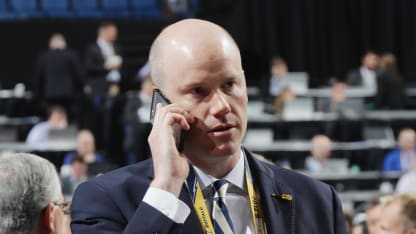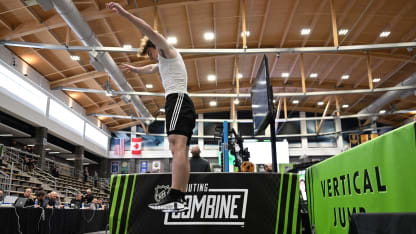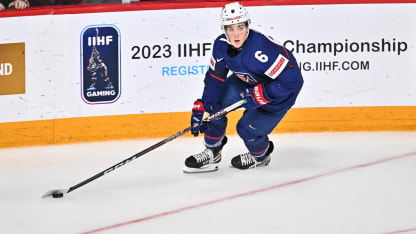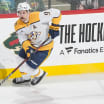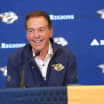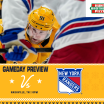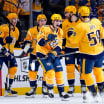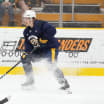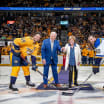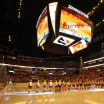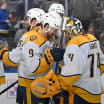When the Nashville Predators landed in Boston on Friday afternoon, the majority of the team and staff headed to their hotel to rest up ahead of the following day’s game against the Bruins at TD Garden. But while they were catching up on sleep or enjoying a nice dinner in the city, one member of the Preds front office was hitting the road for a long night of work.
That afternoon, Assistant General Manager and Director of Scouting Jeff Kealty made the two-hour drive from Boston to Amherst, Mass. – which ended up being closer to three hours in Friday rush hour traffic – to scout a college game between UMass and Michigan.
It’s all in a day’s work for Kealty, who had just returned from a scouting trip to Ottawa and Montreal earlier that day. Kealty is now in his 23rd season with the Predators and oversees all of Nashville's professional and amateur scouting efforts. Before being promoted to Director of Player Personnel in 2017, Kealty spent 11 seasons as Nashville's Chief Amateur Scout. With his experience in amateur scouting all over the world and development of prospects within the Predators system, 10 players who were drafted by the Predators during his tenure are on the team's current roster, including Roman Josi, Colton Sissons and Juuse Saros.
The NCAA is one of the three major pools from which teams select players in the NHL Draft, along with European junior and senior men’s hockey leagues and major junior hockey leagues in Canada and the U.S. Once drafted, a team has the rights of an NCAA player until 30 days after the player leaves the college.
Nineteen different NHL franchises were represented in Friday’s game between the Wolverines and the Minutemen, which featured a total of 22 drafted players – 12 from UMass and 10 from Michigan. In fact, two players on the UMass roster have been drafted by the Predators in recent years – sophomore Cole O’Hara (Round 4, 114th overall in 2022) and junior co-captain Ryan Ufko (Round 4, 115th overall in 2021).
As much as Kealty is evaluating players for the upcoming draft when he attends college or junior hockey games, he is also evaluating opponents’ prospects as potential future trade pieces. A recent example is Reid Schaefer, the former first-round pick acquired by Nashville from Edmonton as part of the trade that sent defenseman Mattias Ekholm to the Oilers ahead of last season’s trade deadline. Another example from Kealty’s tenure is Nashville’s all-time leading goal scorer, Filip Forsberg, a former prospect of the Washington Capitals acquired by the Predators in 2013 in exchange for Martin Erat and Michael Latta.
Another benefit of scouting college games is the opportunity to get eyes on undrafted free agents – think defenseman Jake Livingstone, who was one of the most sought-after collegiate free agents before he signed with the Predators in March following a three-year career at Minnesota State University.
“There are different layers to it,” Kealty said. “The amateur side is getting ready for the next draft. On the pro side, it’s about being up to date on how other teams’ players are doing. Then there’s kind of a middle area… where you see a lot of the colleges and stuff like that. We’re keeping track of other teams’ drafted players and free agents in the college game. We have 15 scouts, so it’s a lot to keep track of.”
With so many moving parts in so many different places, Kealty and his staff use a database to store and share scouting reports on players. They are also in constant communication with one another, with Kealty reporting to General Manager Barry Trotz on a daily basis.
“Everybody always sees the end product, whether it’s the draft or the players that show up on a team years later,” Kealty said. “But there’s just endless hours and travel that go into it. Our guys are all over the world. On a Friday night, our whole staff is doing something like this. It’s kind of cool in that way with players we draft or sign who end up on our team – you’ll remember the trip you took to go see a certain player and years later, he’s on your team.”
An NHL scout’s travel schedule is not for the faint of heart. During hockey season, Kealty estimates he attends roughly four to five games a week in the U.S. and Canada, with trips to Europe every other month. Consequently, his coffee consumption increases exponentially during the season.
“Putting together a schedule is like a puzzle,” Kealty said. “As a scout, you spend a lot of time trying to figure out who you’re going to see, where and when.”
Kealty and his staff put all of this time and effort in throughout the season so that by the time the NHL Scouting Combine rolls around in June, they are essentially confirming what they already know about the prospects they have been scouting for months – sometimes even years – leading up to that point.
“We’re analyzing and watching the kids and spending a lot of time dissecting them all year long,” Kealty said. “You already know everything about them. You put a lot of trust in your area guys to do a lot of that over time, whether it’s talking to the kid’s coaches or the people around the player. Last year, for example, we interviewed 70 kids. You get each kid for 15 to 20 minutes. I think if you’re going to unearth some profound fact about the kid in a 15-minute interview three weeks before the draft, you probably didn’t do a good job up to that point.”
Kealty and his amateur scouts have the unenviable task of trying to predict a player’s NHL potential while he is still developing at the amateur level. It requires a certain amount of guesswork, especially when the players they are scouting are competing with teammates and opponents of varying skill levels.
“It’s not an exact science, especially with the amateur part of it,” Kealty said. “You’re trying to forecast. When you’re watching 17-, 18- or 19-year-old kids in juniors on weeknights, you’re going to see some bad hockey games. But there are NHL players in those games, for sure.”
Kealty and his staff have one of the most demanding jobs in the Predators front office; but when they get to watch the players he scouted as teenagers develop into accomplished NHL players and people, the countless miles traveled, sleep lost, hours seated on uncomfortable bleachers and cups of coffee consumed are all worth it.
"For all the miles that all the scouting staff puts in and all the work that goes into it, when you see it come to fruition like that - I always say that's the most rewarding part of the job,” Kealty said. “It's certainly very special."

